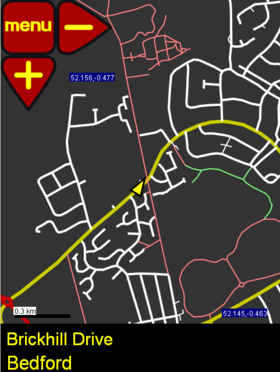Rana/User guide
Moving around
By default the view is centred on your position, so turn that off first (see Following your position below) and then drag the map
Zoom
The two outer buttons of the "group of three" zoom in and out. After a change in zoom you may need to wait for the new map tiles to be generated or downloaded.
Menus
The button at the top-left will activate the menus
Info
Information is displayed at the bottom of the screen. Press this area once to change the page. (it may take a few seconds to respond to your click)
Pages available include:
- Position as lat/long
- GPS status bargraph
- Nearest road/place name
- Speed
- Time
note: speed may be unreliable when replaying a log
Following your position
Toggle whether the map stays centred on your position using Menu → centre. When centred, dragging the map won't work.
note: the first time you use this option it may not do anything (due to the way defaults for undefined options are implemented - this will be fixed soon)
Waypoints
Touch the screen anywhere near the middle to save a numbered waypoint
Tracklogs
Whenever Rana is started, it generates a new timestamped tracklog file, and saves position into that every 2 seconds.
Tracklogs are stored as a simple textfile containing lat,lon (without timestamps), and there is a script available to convert those into GPX if required.
Frequency of trackpoints is controlled using logPeriod (in seconds)
Routing
Currently you can only route to nearby place names:
Menu → Places → (town, city, village) → (select one) → Route
You may wish to set a transport type (see below) before calculating a route
Long routes can take a minute or more to calculate, and the screen won't update while this happens. A status screen is planned.
If the route goes through a new area that data isn't available for, it will try to download map data from the network. If a network is not available, routing may fail.
Once the route is calculated, it will appear as a thick blue line on the map.
note: The route doesn't yet recalculate itself if you leave the route.
Setting a routing mode
The transport type can be adjusted:
Menu → Mode → (select one)
Currently only 3 types of transport are supported:
- Car
- Cycle (default)
- Foot
In future, we hope to support most of the routing profiles.
If you'd like to create or adjust a routing profile, look in the pyroutelib2 directory for the file weights.py. Adding a transport type in here will make it available for rana to use.
Searching
This feature is not yet available (although the menus for it are shown!). In future versions, you will be able to search for nearby pubs, hotels, garages, bike shops, etc. and then create a route or waypoint to get you there.
(this is more of a limitation in OJW's tile data server which currently ignores nodes, rather than in rana)
Sharing position
Not yet implemented. In future you will be able to publish your position to a group, and see other members of that group on your screen

